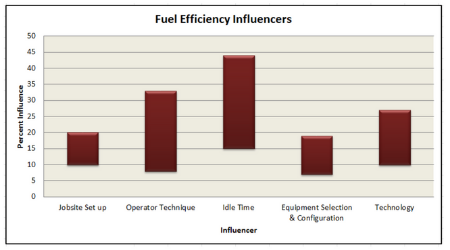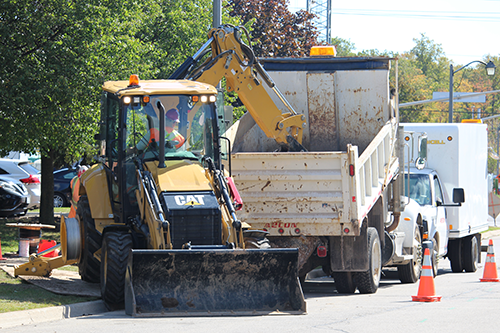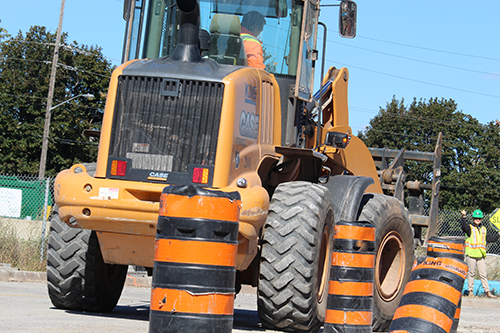Fuel is one of the greatest operating costs for any contractor who owns heavy equipment and/or trucks. Working in a way that can save fuel can end up saving a lot of money.
“At the most basic level, optimizing fuel efficiency comes down to delivering the right amount of fuel and air to the combustion chamber, in the right form and at the right time,” says Alex Eden, product marketing manager, Perkins. “As an end-user, the easiest way to save fuel is to make sure the machines on your jobsite are operating at maximum efficiency by selecting appropriately sized equipment powered by fuel-efficient engines and run by properly trained operators.”
To reduce fuel use, you have to know how and when fuel is being wasted. To gain that knowledge, examine the top five fuel usage influencers in off-highway applications:
- Idle time
- Operator technique
- Jobsite set up
- Equipment selection and configuration
- Technology
Telematics Data
To get good, actionable data, it helps to have your machines equipped with telematics. Telematics provides dozens of points of data on a machine so that you can gain valuable insights that will help save fuel.
“Telematics provides site personnel with fuel information such as idle time fuel consumption, working time fuel consumption and fuel efficiency,” says Jason Hurdis, market professional, Caterpillar. “Having this information allows site personnel to better understand their operations and make continuous analysis of individual machines, operators, and jobsite setup to improve and sustain fuel efficiency.”
“When telematics first was introduced on earthmoving equipment, one of the first benefits realized was for the equipment owner or fleet manager to identify wasteful use of equipment and correct it,” says Brad Stemper, product manager — excavators and wheel loaders — Case Construction Equipment. “Telematics provides data and insights that allow stakeholders throughout the business to drive greater fuel efficiency.”

Idle Time
Idle time is usually the largest contributor to fuel inefficiency. According to Hurdis, idling contributes between 15-45 percent of all fuel-saving potential. “Idling is the first place that people start managing fuel consumption,” he says.
To decrease idle times, operators can take advantage of fuel-saving technology, such as auto idle. “Some idle management systems automatically reduce engine RPM to idle RPM or below normal machine idle RPM. Using these systems can reduce idle fuel consumption to less than one gallon per hour,” says Hurdis. Also popular on modern construction equipment, auto shutdown shuts down a machine if it idles for a preset period of time.
Examine the patterns in your machine’s idle times. If a machine idles for short periods of time (a few seconds to a few minutes) frequently throughout the day, that probably means that machine is at the bottleneck in the workflow, and the operator has to wait for another operator to complete a task before continuing work. In which case, either machine selection, material location or some other jobsite factor will need to change in order to reduce idle time.
However, if a machine idles for several minutes at a time or more, infrequently throughout the day, that probably means the operator is not shutting down the machine when on break, when exiting the machine, when talking on the phone or when having their work interrupted for a longer period of time. In which case, the operator will need to be spoken to regarding company’s expectations, so the operator can take the necessary steps to decrease idle time.
Operator Technique
How an operator uses a machine has a large influence on fuel efficiency. According to Hurdis, next to idling, it has the greatest fuel savings potential. Small changes in behavior can have large effects on fuel use.
“On excavators, operator behavior has a big influence on fuel consumption,” says Matt Mclean, product manager, wheeled excavators, Volvo Construction Equipment North America.
One easy way that operators can save fuel is by using the appropriate work mode. Work modes provide different power levels, so it’s easier for operators to match the power needed to the application at hand. One of these modes is an “eco” mode for maximum fuel savings.
“We generally see operators run machines wide open because they want to use the full extent of the machine’s power—but the vast majority of operations can be completed without that machine at full throttle, says Stemper. “Operators should learn how each operating mode affects each machine and operate accordingly to get the greatest fuel efficiency out of each machine.
“An easy way to conserve fuel is to have operators take the time to learn and use the proper work mode. For example, many operators tend to select the highest setting available even though Volvo engines are designed to achieve the highest torque at the lowest possible RPM,” says Mclean.
 Jobsite Set Up
Jobsite Set Up
In order to set up a jobsite to optimize fuel use, a company needs to examine a lot of data, including equipment capacities, the number of each machine on site, equipment and material locations, terrain and more.
“Jobsite workflow is important, especially when you have equipment that is dependent on the action of the machine/crusher/screener/plant that comes before it,” says Stemper. “That machine has a cycle. Whatever can be done in the setup of a job to shorten that cycle and to minimize idling (so that as much fuel burn is going towards productive work as possible) will have significant improvements on fuel efficiency.”
Telematics offer the potential to gain the insight into how job set up influences fuel use. Telematics monitoring services provide reports on data, such as travel time, idle time and work mode frequency, which can help identify bottlenecks and lead to better decisions about which machines to use, how many machines to use, where they should work and more.
Equipment Selection and Configuration
Choosing the right sized machine for the job comes first. You always want the smallest machine that is capable of doing the job. Larger machines will consume more fuel.
“Know your application, where and how the machine will work, and buy it at the horsepower and operating capacity that best fits the work—that’s large enough to complete the work you do, but not so large that you have considerable wasted energy,” says Stemper.
Important to the goal of greater fuel efficiency is the trend of producing more power and more compact engines. “The move to greater power and torque density means physically smaller engines operating at lower speeds,” says Eden. “The increased performance delivers both packaging and fuel economy benefits. In a recent application, for example, moving from our 4.4- to our 3.6-litre engine yielded a 10 percent fuel saving with no sacrifice in machine performance.”
Once you select the right machine, how you can configure it can also lead to fuel waste. Eric Yeomans, product manager, wheel loaders, Volvo Construction Equipment describes an easy way to save fuel on haulers. “Run a 6x4 configuration whenever possible instead of 6x6. By running in 6x4, the operator saves fuel and reduces tire wear. A 6x6 configuration should only be engaged when running in incredibly muddy or challenging conditions.”
Beyond the size of the engine and configuration, Stemper advises you identify other machine elements that create drag and prevent work from being done efficiently. “Are the cutting edges on all your loader buckets dull? Are your bucket teeth worn or damaged? Are filters clogged and causing the engine to overheat? All of these things create drag on the operation, which leads to lower fuel efficiency,” he says.
 Technological Advancements
Technological Advancements
Besides the technologies mentioned above and a few engine and transmission advancements that don’t need any operator interaction, there are a few other technologies that help improve fuel efficiency. Understanding the fuel-saving technologies on your machines will help you get the most fuel-efficient use out of them.
“Some construction equipment has built-in features and systems that automate control systems, traction aid devices, transmission shift points and engine-hydraulic interactions, all of which the operator can select to enhance their performance and improve fuel efficiency. Recent features added to construction equipment such as performance modes which adjust engine horsepower, hydraulic power, hydraulic speed and rimpull can improve fuel efficiency,” says Hurdis.
Machine guide technology helps improve fuel economy by reducing work needed to complete a task. For example, Volvo’s Dig Assist system for excavators and Load Assist system for wheel loaders, provide accurate data that allows operators to avoid work as a result of having data that is approximate.
“Dig Assist allows the operator to know digging depths and provides a real-time, 3D view of the machine’s movements. Load Assist shows the operator the bucket’s payload within +/- one percent accuracy in real-time—reducing instances of reloading and reweighing,” says Yeomans.
Volvo loaders come with two other technologies designed to save fuel: an “eco pedal” applies a mechanical push-back force in response to excess use of the accelerator and Volvo’s OptiShift technology integrates a lock-up torque converter and a Reverse-By Braking function. “It can also save up to 20 percent more on fuel compared to standard models,” says Yeomans.
So, by tracking how much fuel is being used in which applications, the amount of idle time and other machine data, you can determine when your fuel is being wasted. Combine this knowledge with a complete knowledge of all the fuel-saving features of your machines, and you will be able to get the most out of each gallon.
Join over 32,000 industry peers who receive construction industry news and trends each week. Subscribe to CONEXPO-CON/AGG 365.









